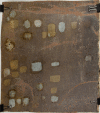Visualising varnish removal for conservation of paintings by fluorescence lifetime imaging (FLIM)
- PMID: 37333623
- PMCID: PMC10276100
- DOI: 10.1186/s40494-023-00957-w
Visualising varnish removal for conservation of paintings by fluorescence lifetime imaging (FLIM)
Abstract
The removal of varnish from the surface is a key step in painting conservation. Varnish removal is traditionally monitored by examining the painting surface under ultraviolet illumination. We show here that by imaging the fluorescence lifetime instead, much better contrast, sensitivity, and specificity can be achieved. For this purpose, we developed a lightweight (4.8 kg) portable instrument for macroscopic fluorescence lifetime imaging (FLIM). It is based on a time-correlated single-photon avalanche diode (SPAD) camera to acquire the FLIM images and a pulsed 440 nm diode laser to excite the varnish fluorescence. A historical model painting was examined to demonstrate the capabilities of the system. We found that the FLIM images provided information on the distribution of the varnish on the painting surface with greater sensitivity, specificity, and contrast compared to the traditional ultraviolet illumination photography. The distribution of the varnish and other painting materials was assessed using FLIM during and after varnish removal with different solvent application methods. Monitoring of the varnish removal process between successive solvent applications by a swab revealed an evolving image contrast as a function of the cleaning progress. FLIM of dammar and mastic resin varnishes identified characteristic changes to their fluorescence lifetimes depending on their ageing conditions. Thus, FLIM has a potential to become a powerful and versatile tool to visualise varnish removal from paintings.
Keywords: Fluorescence lifetime; Fluorescence lifetime imaging (FLIM); Painting conservation; Single-photon avalanche diode (SPAD); Time-correlated single photon counting (TCSPC); Time-resolved fluorescence spectroscopy; Varnish removal.
© The Author(s) 2023.
Conflict of interest statement
Competing interestsAuthors declare no competing financial interests.
Figures











Similar articles
-
A time-correlated single photon counting SPAD array camera with a bespoke data-processing algorithm for lightsheet fluorescence lifetime imaging (FLIM) and FLIM videos.Sci Rep. 2024 Mar 27;14(1):7247. doi: 10.1038/s41598-024-56122-1. Sci Rep. 2024. PMID: 38538638 Free PMC article.
-
Experimental study on merits of virtual cleaning of paintings with aged varnish.Opt Express. 2015 Dec 28;23(26):33836-48. doi: 10.1364/OE.23.033836. Opt Express. 2015. PMID: 26832044
-
Removal of a Past Varnish Treatment from a 19th-Century Belgian Wall Painting by Means of a Solvent-Loaded Double Network Hydrogel.Polymers (Basel). 2021 Aug 10;13(16):2651. doi: 10.3390/polym13162651. Polymers (Basel). 2021. PMID: 34451194 Free PMC article.
-
Fluorescence Lifetime Imaging Techniques-A Review on Principles, Applications and Clinical Relevance.J Biophotonics. 2025 Feb 19:e202400450. doi: 10.1002/jbio.202400450. Online ahead of print. J Biophotonics. 2025. PMID: 39973086 Review.
-
Fluorescence lifetime imaging--techniques and applications.J Microsc. 2012 Aug;247(2):119-36. doi: 10.1111/j.1365-2818.2012.03618.x. Epub 2012 May 24. J Microsc. 2012. PMID: 22621335 Review.
References
-
- Suhling K, Hirvonen LM, Levitt JA, Chung PH, Tregidgo C, Le Marois A, et al. Fluorescence lifetime imaging (FLIM): basic concepts and some recent developments. Med Photonics. 2015;27:3–40. doi: 10.1016/j.medpho.2014.12.001. - DOI
Grants and funding
LinkOut - more resources
Full Text Sources
